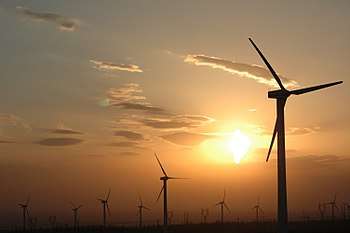Renewable energy in developing countries
Renewable energy technology has sometimes been seen as a costly luxury item by critics, and affordable only in the affluent developed world. This erroneous view has persisted for many years, but 2015 was the first year when investment in non-hydro renewables, was higher in developing countries, with $156 billion invested, mainly in China, India, and Brazil.[1]
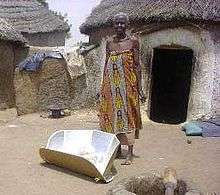
Most developing countries have abundant renewable energy resources, including solar energy, wind power, geothermal energy, and biomass, as well as the ability to manufacture the relatively labor-intensive systems that harness these. By developing such energy sources developing countries can reduce their dependence on oil and natural gas, creating energy portfolios that are less vulnerable to price rises. In many circumstances, these investments can be less expensive than fossil fuel energy systems.[2]
In isolated rural areas, electricity grid extensions are often not economical. Off‐grid renewable technologies provide a sustainable and cost‐effective alternative to the diesel generators that would be otherwise be deployed in such areas. Renewable technologies can also help to displace other unsustainable energy sources such as kerosene lamps and traditional biomass.[3]
Kenya is the world leader in the number of solar power systems installed per capita (but not the number of watts added). More than 30,000 small solar panels, each producing 12 to 30 watts, are sold in Kenya annually. Kenya was the first African country to use geothermal power, and still has the largest installed capacity of geothermal power in Africa at 200 MW, with a potential of up to 10 GW.[4]
Rationale for renewable energy
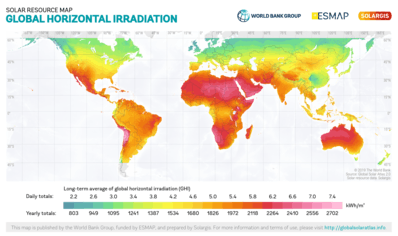
In 2009, about 1.4 billion of people in the world lived without electricity, and 2.7 billion relied on wood, charcoal, and dung for home energy requirements. This lack of access to modern energy technology limits income generation, blunts efforts to escape poverty, affects people's health, and contributes to global deforestation and climate change. Small-scale renewable energy technologies and distributed energy options, such as onsite solar power and improved cookstoves, offer rural households modern energy services.[6]
Renewable energy can be particularly suitable for developing countries. In rural and remote areas, transmission and distribution of energy generated from fossil fuels can be difficult and expensive. Producing renewable energy locally can offer a viable alternative.[7]
Renewable energy doesn't always have to come from a developing country. The Developing Areas Study Group session is a group of speakers from all over the energy businesses discusses the potential ideas to get developing countries the renewable energy that they need. Papers written by W. Morgan, R. Moss and P. Richard discuss the opportunities of renewable resources that lie within the developing country as well. Morgan and Richard claim firewood and agriculture could play a great role in an alternative energy solution in developing countries, while Richards claims that efficient use of agriculture could lead to renewable energy. Morgan also points out that green plants could play a great role in producing synthetic fuel alcohol, which would not only impact the developing country but the world as a whole in providing an alternative fuel source.[8]
Interest in renewable energies has increased in recent years due to environmental concern about global warming and air pollution, reduced costs of the technologies themselves, and improved efficiency and reliability.[7] In recent years, supportive programs from governments, businesses, nonprofit organizations, and community cooperatives have expanded access to these off-grid technologies and the energy services they provide. Program planners should select “low-hanging fruit” first, aiming for maximum access to modern energy services with the least effort.[6]
Use of renewables
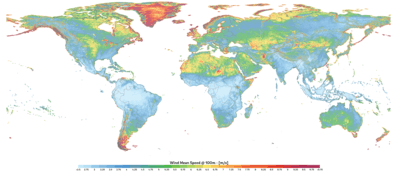
Collectively, developing countries have more than half of global renewable power capacity. China and India are rapidly expanding markets for renewable energy. Brazil produces most of the world’s sugar-derived ethanol and has been adding new biomass and wind power plants. Many renewable markets are growing at rapid rates in countries such as Argentina, Costa Rica, Egypt, Indonesia, Kenya, Tanzania, Thailand, Tunisia, and Uruguay.[10]
In isolated rural areas, electricity grid extensions are often not economical. Off‐grid renewable technologies provide a sustainable and cost‐effective alternative to the diesel generators that would be otherwise be deployed in such areas. Renewable technologies can also help to displace other unsustainable energy sources such as kerosene lamps and traditional biomass.[3]
Technology advances are opening up a huge new market for solar power: the approximately 1.3 billion people around the world who don't have access to grid electricity. Even though they are typically very poor, these people have to pay far more for lighting than people in rich countries because they use inefficient kerosene lamps. Solar power costs half as much as lighting with kerosene.[11] An estimated 3 million households get power from small solar PV systems.[12] Kenya is the world leader in the number of solar power systems installed per capita. More than 30,000 very small solar panels, each producing 12 to 30 watts, are sold in Kenya annually.[13]
Micro-hydro systems configured into village-scale or county-scale mini-grids serve many areas. More than 30 million rural households get lighting and cooking from biogas made in household-scale systems. These stoves are being manufactured in factories and workshops worldwide, and more than 160 million households now use them.[12]
Poverty alleviation
Renewable energy projects in many developing countries have demonstrated that renewable energy can directly contribute to poverty alleviation by providing the energy needed for creating businesses and employment. Renewable energy technologies can also make indirect contributions to alleviating poverty by providing energy for cooking, space heating, and lighting.[2]
Education
Renewable energy can also contribute to education, by providing electricity to schools. Renewable energy for cooking and heating can reduce the time that children spend out of school collecting fuel.[14]
Health
2.4 billion people use only traditional biomass, such as wood, residues and dung, for cooking and heating. The constant use of these types of energy sources exposes them to indoor particulate and carbon monoxide concentrations many times higher than World Health Organization (WHO) standards. "Traditional stoves using dung and charcoal emit large amounts of carbon monoxide and other noxious gases. Women and children suffer most, because they are exposed for the longest periods of time. Acute respiratory illnesses affect as much as 6% of the world population. The WHO estimates that 2.5 million women and young children in developing countries die prematurely each year from breathing the fumes from indoor biomass stoves".[15] Renewable energy can improve this situation by reducing exposure to indoor pollutants.
Furthermore, renewable can also provide energy to refrigerate medicine and sterilize medical equipment in rural areas where the access to electricity is difficult.[16] It can also provide power to supply the fresh water and sewerage services needed to reduce the spread of infectious diseases.[2]
Government policies
More developing countries are implementing the public policies needed for the widespread development of renewable energy technologies and markets, which have traditionally been dominated by Europe, Japan, and North America. The exceptions include countries like Brazil, which has built the world’s leading biofuels industry, China, India, which are leaders in developing decentralized renewable sources such as small hydro, small wind, biogas, and solar water heating.[2] However, policies like feed-in tariff are applied. Besides, with the Kyoto Protocol, the program called the Clean Development Mechanism (CDM) that allows for industrialized nations to invest in projects that reduce emissions in developing countries as an alternative to more expensive emission reductions in their own countries.[17]
Developing-country Governments need to steer resources mobilized for large-scale investments into new production sectors and new technologies. Some argue that policies should base on active industrial policies, combining large scale investments and active policy interventions. There is a need of subsidizing these type of energy services to make them affordable to the major part of the population.[18]
Asia
China
India
Pakistan
Philippines
The Philippine government sees the growth of the renewable energy sector essential for national energy security. The Philippines' fossil fuel sector is unsustainable, being dependent on the import of nonrenewable fuel, including petroleum, but has significant potential in the renewable energy sector. Based on a report of an Australian consulting firm, International Energy Consultants, the Philippines has the highest electricity rate in Asia, followed by Japan. Transmitting power and transporting fuel throughout the Philippine archipelago is problematic due to very high cost.[19]
The Philippines could be considered a world leader in renewable energy, with its 30 percent of its power generation being powered by the renewable energy sector. the Philippines is the world's second largest generator of geothermal energy and was the first Southeast Asian nation to invest in large-scale solar and wind technologies.[19]
Promotion and support of renewable energy in the country was intensified with the passing of the Renewable Energy Act of 2008 which made a feed-in-tariff and a renewable portfolio standard. The Philippines aims to triple renewable energy supply by 2030.[19][20]
Recently the government has concluded agreements with private developers for extensive projects in Oriental Mindoro with an eventual output of 48 MW, with plans for even larger development in the future.[21]
Despite government efforts, some investors have criticized the government's lack of firmness in its feed-in-tariff policy, and the solar industry accused the government for hampering its progress in the country.[22]
Africa
Algeria
On February 3, 2011, Algeria launched the National Development Programme for new and renewable energy and energy efficiency.[23][24] The program, which spans the period from 2011 to 2013, aims to produce 22,000 MW of electricity from solar and wind power which 10,000 MW for export.[25]
Kenya
In Kenya, the Ministry of Energy and Petroleum[26] is in charge of renewable energy policies. In March 2008, the country adopted the feed-in tariff policy. In January 2010, the policy was revised to urge private sectors to invest in electricity generation from renewable sources.[27]
Kenya was the first African country to use geothermal power, and still has the largest installed capacity of geothermal power in Africa at 200 MW, with a potential of up to 10 GW.[4] The only other country in Africa utilising geothermal power is Ethiopia.
Kenya is the world leader in the number of solar power systems installed per capita (but not the number of watts added). More than 30,000 small solar panels, each producing 12 to 30 watts, are sold in Kenya annually. For an investment of as little as $100 for the panel and wiring, the PV system can be used to charge a car battery, which can then provide power to run a fluorescent lamp or a small television for a few hours a day. More Kenyans are turning to solar power every year rather than making connections to the country’s electric grid. This is due to the high connectivity costs and the fact that there is an abundance of solar power in Kenya.[28]
Latin America and the Caribbean
Brazil
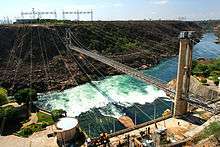
Renewable energy accounted for more than 85.4% of the domestically produced electricity used in Brazil, according to preliminary data from the 2009 National Energy Balance, conducted by the Energy Research Corporation (EPE).[29] After the oil shocks of the 1970s, Brazil started focusing on developing alternative sources of energy, mainly sugarcane ethanol. Its large sugarcane farms helped. In 1985, 91% of cars produced that year ran on sugarcane ethanol. The success of flexible-fuel vehicles, introduced in 2003, together with the mandatory E25 blend throughout the country, have allowed ethanol fuel consumption in the country to achieve a 50% market share of the gasoline-powered fleet by February 2008.[30][31]
Costa Rica
Renewable Energy in Costa Rica accounts for over 90% of the total output of the nation's energy. The country is the world leader in renewable use with massive investment in windmill technologies. The government aim is to make the country the world's first carbon neutral country.[32][33] In March 2015 the whole country was running over 75 straight days on 100% renewable energy.[34]
See also
- Agency for Non-conventional Energy and Rural Technology
- Ashden Awards for Sustainable Energy
- Clean-burning stove
- Indian Solar Loan Programme
- International Renewable Energy Agency
- Renewable energy in Africa
- Renewable energy in Asia
- Solar powered refrigerator
- SolarAid
- UN-Energy
- Wind power in Asia
- Gaspar Makale
References
- FS-UNEP Collaborating Centre, Global trends in renewable energy investment, 2016 p. 14.
- Energy for Development: The Potential Role of Renewable Energy in Meeting the Millennium Development Goals pp. 7-9.
- IEA (2011). "Renewable Energy" (PDF).
- http://en.ccchina.gov.cn/Detail.aspx?newsId=38323&TId=97
- "Global Solar Atlas". Retrieved 7 December 2018.
- Sovacool, Benjamin K. (5 October 2012). "Deploying Off-Grid Technology to Eradicate Energy Poverty". Science (vol. 338, 47-48). SSRN 2198045.
- Power for the People Archived 2012-03-30 at the Wayback Machine p. 3.
- McDonald, Paul (1980). "Energy in Developing Countries". Area. 12 (1): 78–79. JSTOR 20001554.
- "Global Wind Atlas". Retrieved 7 December 2018.
- REN21 (2010). Renewables 2010 Global Status Report Archived 2010-08-20 at the Wayback Machine p. 9.
- Kevin Bullis (January 27, 2012). "In the Developing World, Solar is Cheaper than Fossil Fuels". Technology Review.
- REN21 (2010). Renewables 2010 Global Status Report Archived 2010-08-20 at the Wayback Machine p. 12.
- "The Rise of Renewable Energy" (PDF). Retrieved 2011-11-21.
- Ashden Awards. "Grameen Shakti installs efficient stoves as well as solar home systems". Retrieved 2008-11-25.
- "IAEA BULLETIN, 44/2/2002" (PDF). pp. 28, 29.
- Ashden Awards. "PV-powered vaccine fridges". Retrieved 2008-11-25.
- Adaptation Fund
- "World Economic and Social Survey 2009 Promoting Development, Saving, 2009, the Planet" (PDF). pp. 4, 11.
- http://www.mb.com.ph/articles/325264/the-right-mix-the-philippines-achieving-its-renewable-energy-goals
- http://www.abs-cbnnews.com/business/06/14/11/philippines-lifts-2030-renewable-energy-target
- http://samueldalsanto.com/2012/04/14/samuel-helps-philippines-wind-power-project-get-presidential-approval/
- http://www.cleanbiz.asia/story/policy-problems-hamper-philippine-renewables-growth
- Adoption of the Algerian program of renewable energy and energy conservation policy
- Algerian Development Programme for new and renewable energy and energy efficiency
- Algerian Development Programme for new and renewable energy and energy efficiency (List of projects)
- The Ministry of Energy http://www.energy.go.ke/?page_id=2
- http://www.energy.go.ke/wp-content/uploads/2010/08/feed%20in%20tarriffs2.pdf
- The Rise of Renewable Energy
- Renewable energy in Brazil
- Agência Brasil (2008-07-15). "ANP: consumo de álcool combustível é 50% maior em 2007" (in Portuguese). Invertia. Archived from the original on 2008-12-26. Retrieved 2008-08-09.
- 90% of cars produced in Brazil are Flexfuel
- Latin America Venture Capital Association (13 July 2010). "Latin American Policy Changes: Investing in Renewable Energy, Climate Change and Clean Technology".
- Natural Resources Defense Council (NRDC) (June 2007). "Costa Rica: Setting the Pace for Reducing Global Warming Pollution and Phasing Out oil" (PDF).
- "Costa Rica powered with 100% renewable energy for 75 straight days". March 2015.
